A barely-discernible veil of powdered sugar still lingers on every surface of my kitchen. The wine closet has an alarming number of empty slots. The deli drawer in my refrigerator—once crammed with an enviable assortment of decadent triple-crème cheeses—now houses one teeny chunk of Parmesan.
It’s January. The Season of Excess has officially ended. The past six weeks were filled with good food—and much of it was reasonably healthy. At least, it started out healthy. It’s just all the other stuff I ate along with it that has transported me into The Land of Elastic Waistbands.
Sweet potatoes are a perfect example. From Thanksgiving forward, they played center-stage in many festive meals. And had I the fortitude to scrape away the gooey marshmallow topping, candied nuts, puddles of melted butter, and/or molten brown sugar, I would have been left with something quite nutritious.Maybe I’ll try that next year.
For now, fellow January dieters can rejoice that sweet potatoes are one of the few starchy vegetables that ranks low on the glycemic index. They are also high in vitamins and A, B6, C and D; and a good source of potassium, calcium, folate, magnesium, iron, and beta-carotene.
Sweet potatoes are born with paper-thin skin and a high ratio of starch to sugar. (They’re not terribly desirable at this stage.) Only after a designated period of climate-controlled storage does the skin thicken into a protective barrier, and the starch contained within convert to sugar—resulting in the sort of sweet potato we know and love.
Shopping at the farmers’ market ensures you are purchasing the best possible product at its peak of perfection. There you’ll find a wide assortment of sweet potato varieties, grown both organically and conventionally. Whichever you choose, they’re ready to bring home and steam, bake, boil, sauté, or microwave into maximum deliciousness. These farmers’ market sweeties have also been handled far less than their supermarket siblings, reducing the likeliness of bruising, soft spots, and subsequent rot.
Growers divide sweet potatoes into two basic categories: moist and dry. The moist ones—commonly called yams—have reddish skin and bright orange flesh that’s sweet and moist. They also have colorful names like Garnet and Jewel and Beauregard. This variety is now officially recognized as one of America’s top-ten “super-foods.” Which means: They rock.
The dry ones—often labeled generically as “sweet potatoes”—have golden skin and pale yellow flesh that isdrier and more bland than sweet, with a floury texture reminiscent of a baking potato.
For the best results, select small-to-medium sweet potatoes that feel heavy for their size. Farm-fresh sweet potatoes remain fresh for at least seven days when stored in a cool, dry cupboard. Do not store them in the refrigerator.
An unadorned sweet potato baked in its skin is a healthy, flavorful alternative to traditional white potatoes. On these cold days, however, nothing beats the comfort ofwarm soup—especially when it looks appetizing; delivers an unexpected kick; tastes rich and creamy, and yet contains only a smattering of fat. The following recipe provides all that in less than one hour, from start to finish.
I happen to enjoy the velvety texture of pureed soup, but feel free to skip that step if you consider it too fussy. Or if you want to get truly fancy, top each serving with a drizzle of sour cream and/or some chopped fresh cilantro. This soup freezes perfectly, so there’s no reason not to double the recipe.
Smoky Sweet Potato Soup
1 tablespoon olive oil or butter
1 small yellow onion, chopped
1 pound red-skinned sweet potatoes (about 2 medium or 3 small), peeled and cut into 1-inch chunks
1 garlic clove, chopped
Fine sea salt
3 cups (24 ounces) chicken stock or low-salt chicken or vegetable broth
1 teaspoon finely chopped canned chipotle chile peppers in adobo sauce*(use only 1/2 teaspoon if you don’t care for spicy food)
3/4 teaspoon ground cumin
1/2 teaspoon smoked paprika
Juice of 1 lime, plus 1 more lime cut into wedges for serving
- In a soup pot or large saucepan, warm the oil over medium heat. Add the onion and cook, stirring occasionally, until softened but not browned, 5 to 7 minutes.
- Stir in the sweet potatoes, garlic, and 1/2 teaspoon of salt and cook about 2 minutes longer. Pour in the stock,and stir in the chipotle, cumin, and paprika. Increase the heat to high and bring to a boil; then reduce the heat to low and cook, partially covered, until the sweet potatoes are very tender, 15 to 20 minutes.
- Using a hand-held immersion blender, puree the soup until smooth. (Alternatively, let the soup cool to room temperature. Working in batches, puree in a blender until smooth; then return to the pot to re-heat.) Stir in the lime juice. Taste, adding more salt if needed. Serve hot, and pass the lime wedges at the table. Makes 4 cups.
*Chipotles are smoked jalapeño chiles. Small cans of chipotle peppers in spicy adobo sauce are available in Latin markets, or in the Mexican foods section of most supermarkets.Remove as many chiles as you need from the open can, and transfer the remaining chipotles and adobo sauce to a small jar with a tight-fitting lid. It will keep in the refrigerator indefinitely, so you’ll always have chipotles on hand to perk up your cooking.
The Danville Certified Farmers’ Market, located at Railroad and Prospect, is open every Saturday, rain or shine, from 9 a.m. until 1 p.m. For specific crop information call the Pacific Coast Farmers’ Market Association at 1-800-949-FARM, or visit their web site at www.pcfma.com. This market is made possible through the generous support of the Town of Danville. Please show your appreciation by patronizing the many fine shops and restaurants located in downtown Danville. Buy fresh. Buy local. Live well.
Leave a Reply